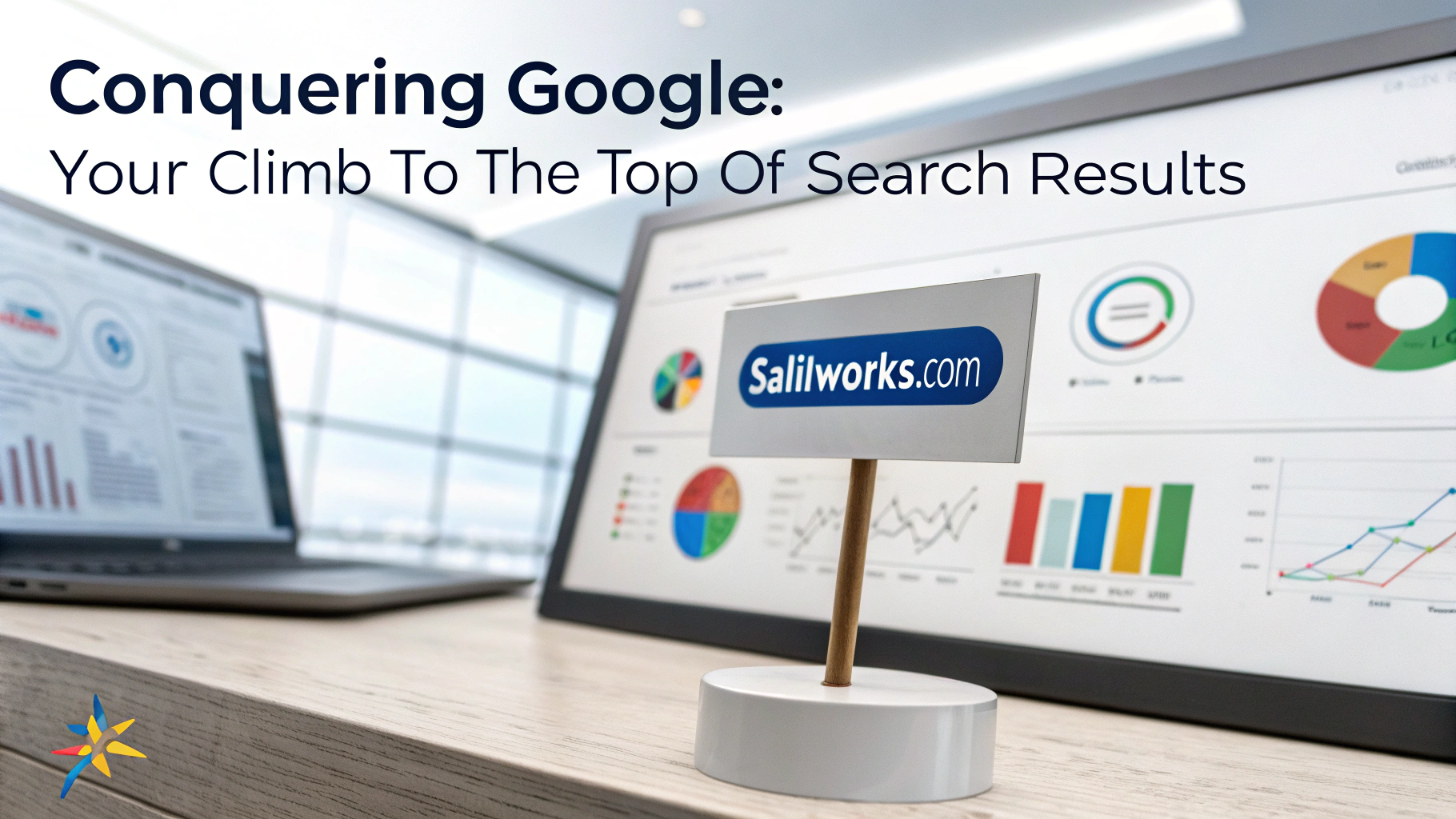Conquering Google: Your Climb to the Top of Search Results
Ever wondered why only 0.63% of Google searchers click on results from the second page? The digital landscape is a vertical battlefield where your position determines visibility, and the SEO Ascent to the top is the difference between thriving and merely surviving online. With 68% of online experiences beginning with search engines, mastering the climb to ranking dominance isn’t optional—it’s essential for business survival.
Let’s explore how to strategically elevate your website from the depths of search obscurity to the summit of page one results.
Why It Matters

The harsh reality: 75% of users never scroll past the first page of search results. This digital precipice means that without proper SEO Ascent strategies, your business essentially becomes invisible, regardless of your product or service quality.
Recent research shows that the top position on Google’s search results has an average click-through rate of 31.7%, while the tenth position gets only 3.1%. This exponential drop illustrates the competitive advantage of ranking higher—each step up this mountain significantly impacts traffic, leads, and revenue.
For businesses, this translates directly to the bottom line. Companies appearing on the first page of Google capture 92% of all traffic from an average search, with traffic dropping by 95% for pages ranking on the second page.
Core Concepts
The SEO Ascent framework rests on three foundational pillars:
-
Technical Foundation: Think of your website as a mountain climber’s equipment—if your base gear (site speed, mobile responsiveness, crawlability) isn’t optimized, you’ll never reach the summit. Sites loading within 2 seconds have an average bounce rate of 9%, while those taking 5 seconds see that rate jump to 38%.
-
Content Excellence: Your content is your climbing strategy—methodical, valuable, and aligned with search intent. High-quality, comprehensive content acts as your oxygen supply throughout the climb.
-
Authority Building: Consider backlinks as your Sherpas—trusted guides that validate your journey to search engines. Websites with robust backlink profiles from authoritative sources can rank for 52.2% more keywords than those with minimal external validation.
Companies implementing these core principles experienced a 54% increase in organic traffic within six months, according to a recent industry analysis.
Strategy or Implementation Guide
Step 1: Technical SEO Audit
Begin your SEO Ascent with a comprehensive site audit. Identify and fix:
- Page speed issues (compress images, leverage browser caching)
- Mobile usability problems
- Crawl errors and indexing issues
- Schema markup opportunities
- Site architecture and internal linking weaknesses
Implement a quarterly technical audit schedule to maintain optimal site health—think of it as regular equipment checks during your climb.
Step 2: Keyword Research and Content Mapping
Identify your target keywords based on:
- Search volume and competition
- User intent alignment
- Conversion potential
- Business relevance
Create a content calendar that addresses different stages of the buyer journey, ensuring you’re building helpful content signposts along the user’s path.
Step 3: Content Creation and Optimization

Develop content that demonstrates E-E-A-T (Experience, Expertise, Authoritativeness, and Trustworthiness):
- Create comprehensive guides exceeding 1,500 words for competitive terms
- Include data-backed insights and original research
- Optimize on-page elements (title tags, headers, image alt text)
- Incorporate semantic variants to enhance topical relevance
- Update existing content regularly—freshness signals matter in your SERP Climb
Step 4: Authority Building Strategy
Implement a systematic approach to earning quality backlinks:
- Create linkable assets (research reports, tools, infographics)
- Develop relationships with industry publications
- Leverage digital PR opportunities
- Guest post on relevant, authoritative sites
- Monitor and disavow toxic backlinks
Organizations executing consistent link-building campaigns saw a 38% improvement in Ranking Summit outcomes compared to those focusing solely on on-site optimization.
Benefits
Successfully executing an SEO Ascent strategy delivers measurable business advantages:
-
Sustainable Traffic Growth: Unlike paid campaigns, organic search traffic continues delivering value without ongoing costs. Businesses reported 87% lower acquisition costs for organic leads compared to PPC.
-
Enhanced Credibility: 49% of users report that they trust Google’s algorithm to surface the most reliable information, meaning high rankings translate to perceived trustworthiness.
-
Improved Conversion Rates: Users finding your site through organic search have 14% higher conversion rates than social media traffic, as they’re actively seeking solutions you provide.
-
Competitive Intelligence: The SEO process reveals valuable market insights about customer preferences and competitor strategies that can inform broader business decisions.
Case Study
A mid-market SaaS company implemented our SEO Ascent protocol after struggling with flat organic growth. Their key actions included:
- Reducing site load time from 4.3 to 1.8 seconds
- Creating 24 comprehensive guides targeting high-intent keywords
- Developing a systematic link-building program focusing on industry publications
Results after 6 months:
- 167% increase in organic traffic
- 43% growth in demo requests
- 22% reduction in customer acquisition costs
- First-page rankings for 78% of target keywords
Tools & Resources
Equip yourself for the SERP Climb with these essential tools:
- Semrush/Ahrefs: Comprehensive keyword research and competitor analysis
- Google Search Console: Monitor performance and technical issues
- PageSpeed Insights: Identify and fix speed bottlenecks
- Surfer SEO: Optimize content against top-ranking competitors
- Screaming Frog: Conduct thorough technical audits
- HARO (Help A Reporter Out): Connect with journalists for backlink opportunities
Common Mistakes to Avoid
- Keyword Stuffing: Focus on natural language optimization rather than forcing keywords unnaturally
- Ignoring Search Intent: Align content with user goals (informational, navigational, transactional)
- Neglecting Mobile Experience: With mobile-first indexing, your mobile experience determines rankings
- Chasing Algorithm Changes: Build for users first, algorithms second
- Expecting Immediate Results: The SEO Ascent takes time—expect 4-6 months for significant movement
Future Trends
The search landscape continues evolving. Prepare for these emerging trends:
- AI-Generated Search Results: Google’s SGE and AI summaries will reshape SERP interactions
- Voice Search Optimization: More conversational queries requiring natural language optimization
- Visual Search Growth: Image-based searches becoming increasingly prevalent
- Core Web Vitals Evolution: User experience metrics gaining even more ranking significance
- Entity-Based SEO: Moving beyond keywords to topic authority and entity relationships
Conclusion
The SEO Ascent to search dominance isn’t a sprint but a strategic expedition requiring technical excellence, content mastery, and relationship building. By implementing the framework outlined here, you position your business to capture the 68% of market share that lives on page one.
Remember: every optimization is a step toward the summit. Begin your climb today, and transform your digital visibility from an afterthought to your greatest competitive advantage.
Ready to accelerate your journey to the top? Contact our team for a free SEO audit and discover how we can help you reach the Ranking Summit faster than you thought possible.
FAQs
How long does it take to see results from SEO efforts?
While some improvements may be visible within weeks, significant ranking changes typically take 4-6 months due to algorithm evaluation periods and competitive factors.
Is SEO still relevant with the rise of social media marketing?
Absolutely. Search remains the highest-intent channel, with 68% of online experiences beginning with a search engine. Social media complements but doesn’t replace the value of search visibility.
How much should I invest in SEO compared to other marketing channels?
Most successful companies allocate 15-25% of their digital marketing budget to SEO, recognizing its superior long-term ROI compared to paid channels.
Can small businesses compete with larger companies for rankings?
Yes, by focusing on niche-specific keywords, local SEO, and specialized content areas where larger competitors haven’t established dominance.
How often should I update my SEO strategy?
Conduct comprehensive strategy reviews quarterly, with ongoing content refreshes and technical monitoring. Major algorithm updates may require more immediate strategic pivots.

